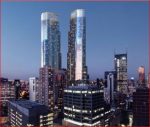WYNNE SHOWS CONTEMPT FOR PANEL AND PUBLIC
“Halfway through its term, Victorian Labor has joined the big-city development camp. Labor’s strategy is to side with vested interests while pretending to listen to rising resident concerns about rampant development. But packed public meetings across the metropolitan area are demanding greater development regulation, pitting residents against big capital, unions and compliant gov’t”.
Michael Buxton is Professor Environment and Planning, RMIT University.
In the Age Newspaper article, 11/12/16, he writes : No government ever asked the people of Melbourne if they wanted their city to become a high rise metropolis. No plan set such a goal. Governments decided for us. One explanation for Labor’s approach is its addiction to land-related tax revenue – currently at about $7.6 billion annually – and its desperation to maintain the construction industry share of 7 per cent of state production. The construction industry wields enormous influence through its multi-layered development, business and service elements. Peak development groups lobby effectively. Unions are a powerful lobby group with Labor. One example of the government’s approach is the recent rules
for high rise residential towers in the central city. These are cosmetic, designed to appease the development industry under the fiction of government control. Extensive development will continue under one of the developed world’s highest site densities with a plot ratio of 18:1. Developers gain bonuses to build even higher for providing ill-defined public benefits. Many cities require measurable public benefits as part of the approval process, not as an incentive to an already generous rule.
Planning Minister Richard Wynne recently demonstrated the grotesque results from this approach, approving a tower which grew to a plot ratio of 29:1 and 70 storeys. The public benefit seemed to be mainly the minister’s appreciation for the tower design. Wynne ignored an independent review panel’s recommendation to abandon the bonus scheme. His failure to provide reasons shows contempt for the panel and the public.
There is no lack of infill land and other development sites. In the central city, apartment supply equals projected residential demand until 2031. By early 2016, about 100 high rise apartment buildings were under construction, planned or had gained recent permits, potentially doubling the number of high rise buildings in the central city. Some densities are over four times those of Hong Kong and Tokyo”.
Mr Wynne said the two towers were not designed to “mimic Manhattan” and rejected suggestions the towers could contribute to an apartment glut in the city. “We do not have an apartment glut and this is a development that is actually catering for families,” he said.”It speaks, I think, to many families who are using the opportunity of apartment-style dwellings.”While there is mixed views about an oversupply, we have no evidence to that effect.”
GOVERNMENT RENEGED ON ITS PROMISE TO LIMIT HEIGHT OF APARTMENTS
September last year developers and the property industry had turned on the Andrews government over dramatic and unexpected changes made last September to the laws around heights and densities for new Melbourne CBD buildings.
The changes meant that Melbourne’s surge of crowded skyscrapers would be reined in, potentially leaving developers millions of dollars out of pocket.
Planning Minister Richard Wynne brought in the new restrictions at midnight on Friday September 11th 2015 with no notice to the development industry because of fears within government of an avalanche of applications for super-tall skyscrapers.
The new laws were likely to significantly reduce the height of Melbourne’s future towers, because a developer who builds to the borders of their block would be restricted to 24 floors.
Alternatively the new laws would have lead to an increase in open space, because those who apply to the minister to go higher will need to provide offsets such as open space

4 Comments
All Australia’s manufacturing industry has gone, the mining sector is no longer what it was and pretty soon the building industry will collapse in similar fashion to other countries who have allowed their property market to overheat. This guy Wynne cannot be trusted and the whole planning process is corrupt.
Resale prices of apartments appear to be a problem. An apartment, 71m2 plus Balcony and two car spaces, near Westfield Doncaster, purchased for $535,000 in 2011, was recently sold for $485,000 a loss of $50,000 in five years.
They appoint an independent panel then have the temerity to refuse to accept it’s recommendation shows just how much this mob is controlled by the construction industry.
“We do not have an apartment glut and this is a development that is actually catering for families,” he said.”It speaks, I think, to many families who are using the opportunity of apartment-style dwellings.”While there is mixed views about an oversupply, we have no evidence to that effect….PLEASE!!